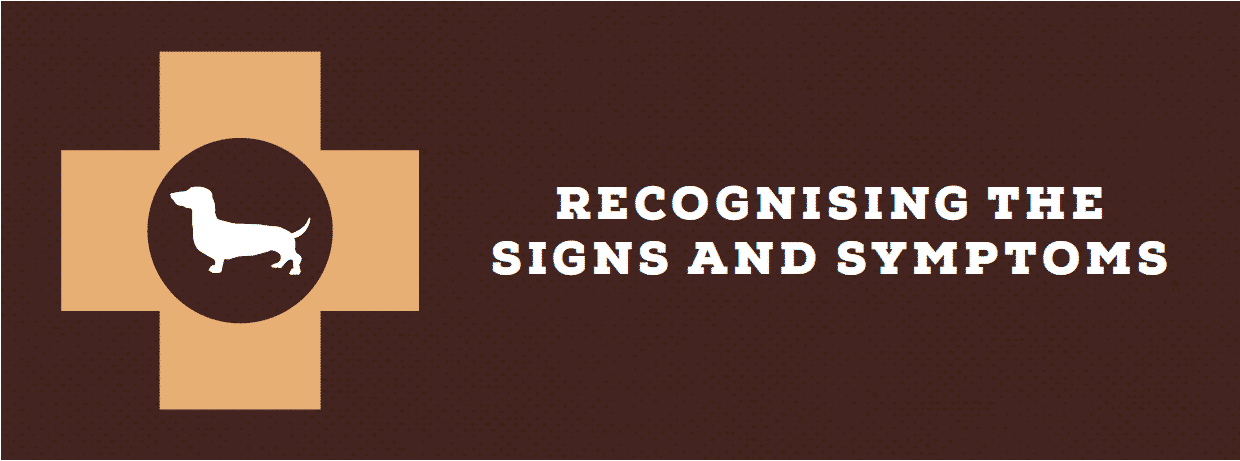We can’t stress enough the importance for all dachshund owners to be aware and recognise all the signs and symptoms of back disease and the possibility of disc herniation.
Sadly, not all vets are aware so the onus comes down to dachshund owners to learn all about it and what to look out for. If you suspect that any one of your dachshunds shows any one of the following signs and symptoms, please seek veterinary advice immediately.
Time is of absolute essence in recognising the signs and symptoms, so it’s important to act fast. Once your dachshund has been neurologically assessed an appropriate management plan will be put in place. Here, in this section, we teach you all about those signs and symptoms.

A Reluctance to Move and go about Daily Activites
Your dog may refrain from running around, jumping up on furniture or yourself, refuse to walk up or down stairs and / or refrain from standing / jumping up on its back legs.
Unusually Quiet or Withdrawn
When in pain, your dog may spend a lot of time sleeping / lying in a place that’s not a part of his normal routine. Your dog may also take to hiding or sitting in a corner or start to display odd “comforting” behaviour (i.e. spend a lot of time with a soft toy which is out of character).
Trembling, Shaking, Crying and / or Yelping
Thanks to pain, your dog may also show aggression towards you, family members or other pets which is otherwise very out of character. Your dog may also pant a lot or sigh / cry softly. In some cases, when pain is severe, your dog may avoid eating or not eat as much as usual.
Sensitivity to Touch
When you touch your dog it may yelp or cry out in response and perhaps even act aggressively towards you. In some cases your dog may go about avoiding you to prevent you from picking him up or patting him.
Avoids a Full Body Shake
Your dog may very well avoid a “full” and “vigorous” body shake if it has a sore back. He may also avoid rolling onto his back and instead lie on his bed in a “stiff” manner.
Hunched Back
A dog with disc issue sends to develop a hunch in his back – a hunch may be severe or it may also appear in a manner where it looks like one or two vertebra are protruding from the spine slightly. The dog may also move around via slow and shuffled walking and have a tense belly.
Limping or Walking Unusually
If your dog appears to be falling over, walking stiffly or appears like his back knees are collapsing, this could indicate he has a disc issue.
Head Held High or Low with a Stiff Neck
Your dog may not want to lift its head at all or hold it at a funny angle.
Any Form of Lameness in the Front Legs, Lifting Head Forward & Hanging it Low
This could be an indication that your dog is experiencing a cervical episode of IVDD.
Spasms in the Neck Muscles
Your dog may suffer neck spasms and episodes of spontaneous crying including wobbling on all four legs (ataxia) with cervical IVDD.
As Damage to the Spinal Cord Increases Your Dog’ Symptons May Worsen:
Severe Pain
This is often displayed through uncomfortable trembling shaking – it may appear like your dog has a fever. Your dog may also pant like he’s incredibly hot or whine/cry.
Drunk Walking
Your dog’s back legs may appear wobbly or cross over and appear as if he’s very “drunk”. The back paws may also “toe” or “knuckle over” when walking or standing or your dog may drag one or more legs when walking.
Cannot Stand or Wag Tail
If your dog cannot stand on his own or bear weight on his back legs and he cannot wag his tail, he has reached a critical stage and paralysis may be imminent.
Loss of Bowel Control and Cannot Urinate
If your dog soils his bed unexpectedly and is unable to stand to urinate, emergency veterinary assistance is required.
No Interest in Food
A dog in severe pain will not be interested in eating and will not respond to being offered treats or food.
Has No “Deep Pain Sensation”
This will be determined by a specialist vet – “deep pain sensation” is a vital nerve function.
